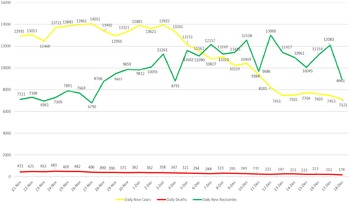Coronavirus disease 2019 (COVID-19) was first identified in December 2019 in Wuhan, China. COVID-19 is highly contagious and has a high risk of infection. Reference Huang, Wang and Li1,Reference Zhu, Zhang and Wang2 The first positive case of COVID-19 disease in Iran was announced on February 18, 2020, and gradually new cases were discovered in all cities of Iran. Reference Peyravi, Soltani and Ahmadi3 According to the reports of the Ministry of Health of Iran, as of December 15, 2020, the total number of patients was 1,123,474: 52,670 died, and 833,276 recovered. From the very first days, the Government of the Islamic Republic of Iran took significant measures that led to the control and prevention of further deaths of COVID-19. Reference Peyravi, Soltani and Ahmadi3,Reference Peyravi, Marzaleh and Shamspour4 Control of COVID-19 is a multifaceted and extra-organizational action, so even with the implementation of good policies and programs, if the national and popular tendency is not to control COVID-19, the results may not be effective and efficient, and good control may not be exercised. In the fall of 2020, the number of cases and deaths increased significantly, and there were several peaks in the increase in deaths and infections. Therefore, the Iranian government decided to quarantine and close the country from November 21 to December 4, 2020. For 2 wk, all government offices and businesses, schools and universities were closed. After this period, according to the surveys, the cities were divided into 3 states: red, orange, and yellow, and for each of the situations, high to low limits were considered. This study examines the effects of a 2-wk lockdown in Iran and the impacts, challenges, and recommendations of the COVID-19 pandemic.
Impacts: (1) Reduction in mortality (according to Figure 1), (2) Increase in the number of daily improvements, and (3) Saving the government spending and budgets.

Figure 1. Daily new cases, daily deaths, and daily new recoveries during the lockdown period in Iran in the period from November 21 to December 18, 2020.
Challenges: (1) Irregularity in the transition of daily affairs, (2) Economic problems for vulnerable and poor groups, (3) Imposition of virtual education on universities and reduction of the quality of education, and (4) Negative impact on people’s mental health.
Recommendations: (1) Supporting small and medium enterprises (SMEs) financially and nonfinancially by the government; (2) Continuing subsidies to businesses; (3) Developing free and high-speed Internet in all parts of the country, even in inaccessible areas; (4) Practicing tax exemptions for businesses and people; (5) Holding meetings, national and local events virtually in a webinar; (6) Tracking patients and preventing them from entering public places and communities; (7) Developing E-learning; (8) Imposing stricter restrictions on cities and areas with high mortality and morbidity; (9) Giving cities full authority to plan for reopening or lockdown; (10) Increasing the people’s psychological resilience; and (11) Developing telemedicine and home health services.
Conclusions
The results of Figure 1 show that the daily new cases and daily deaths of COVID-19 significantly decreased. The number of recovered cases also increased. Long-term lockdown can do great damage to the economy of the countries; however, continuous and periodic lockdown seems to affect the reduction of morbidity and mortality, so this approach should be implemented over long periods of time. The benefits of a total lockdown in Iran outweigh the disadvantages; however, governments should consider programs and plans to support people and businesses so as not to impose more hardships on the people. The government can contribute to local, more accurate, and systematic pandemic planning by giving the COVID-19 management full control over the cities individually by implementing programs and policies at the national level according to the different conditions of the cities. Socio-economic factors affecting health play an important role in people’s health. During lockdown, poor people and families in the lower social classes are usually more vulnerable. This vulnerability is exacerbated by the fact that families are unable to earn a living due to forced lockdown. Strengthening health equity for all sections of society, especially the poor, can reduce the negative effects of lockdown. Therefore, in future studies, it is suggested that the impact of social factors affecting public health during lockdown be carefully analyzed.
Conflict of Interest
The authors have no conflict of interest to declare.



